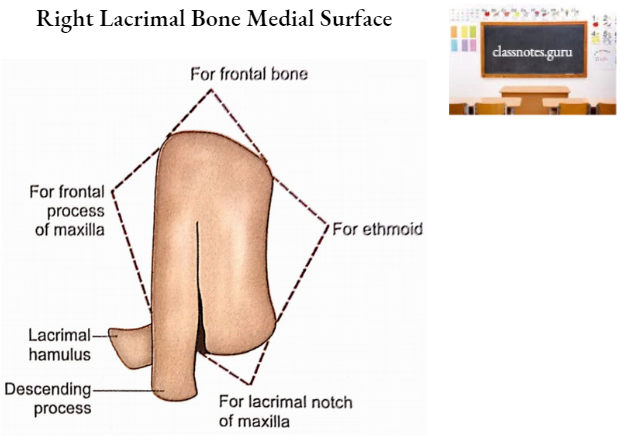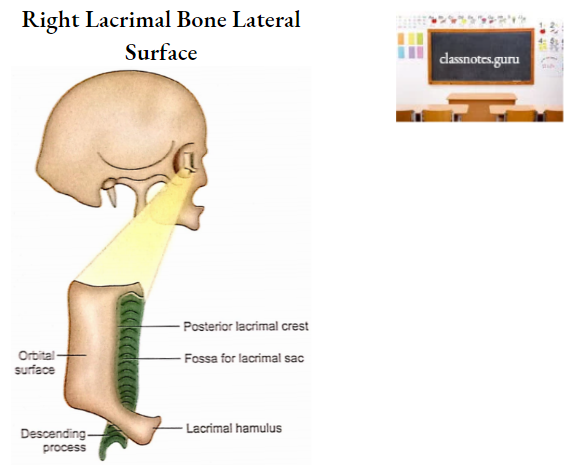Lacrimal Bones
Lacrimal Bones Terminology
‘Lacrimal’ is a Latin word which means ‘tear’. The bone is so named because of its relation with the tear sac.
Lacrimal Bones Peculiarities
- It is most fragile among the cranial bones.
- It is the smallest of the cranial bones.
Lacrimal Bones Location
- There are two lacrimal bones.
- Each lacrimal bone is located in the anterior part of the medial wall of the orbit.
- It also contributes to the middle meatus of the nose.
Lacrimal Bones Features And Attachments
Lacrimal bone is rectangular in shape. It has two surfaces (medial and lateral) and four borders (anterior, posterior, superior, and inferior).
Lacrimal Bones Surfaces
1. Medial Surface
- It is also called the nasal surface.
- Its anteroinferior part contributes partly to the middle meatus of the nose.
- Its posterosuperior part articulates with the ethmoid and completes a few anterior ethmoidal air cells.

2. Lateral Surface
- It is also known as the orbital surface.
- It is divided into anterior and posterior parts by a vertical crest called the posterior lacrimal crest.
- The anterior part is grooved and forms the posterior half of the floor of the lacrimal groove.
- The anterior half of the lacrimal groove is formed by the frontal process of the maxilla. The groove lodges the lacrimal sac.
- The portion behind the posterior lacrimal crest is smooth and forms part of the medial wall of the orbit.
- The lower end of the posterior lacrimal crest projects forward as the lacrimal hamulus.
- It articulates with the maxilla to complete the upper end of the nasolacrimal canal.
- The posterior lacrimal crest provides attachment to the lacrimal fascia.
- The crest and small area of the lateral surface immediately behind it give origin to the lacrimal part of the orbicularis oculi muscle.
- The medial wall of the groove projects downwards in a descending process.
- This process articulates with the lips of the nasolacrimal groove of the maxilla and the lacrimal process of the inferior concha to complete the bony canal for the nasolacrimal duct.

Lacrimal Bones Borders
- Anterior Border
- It articulates with the frontal process of the maxilla.
- Posterior Border
- It articulates with the orbital plate of the ethmoid.
- Superior Border
- It articulates with the nasal notch of the frontal bone.
- Inferior Border
- It articulates with the orbital surface of the maxilla.
Lacrimal Bones Ossification
Lacrimal bone ossifies in membrane.
2. A single center of ossification appears in the mesenchyme around the cartilaginous nasal capsule.
3. The center appears at about the 12th week of intrauterine life.
Lacrimal Bones Applied Anatomy
- A severe impact on the nasal bridge may involve the lacrimal bone and damage the lacrimal passage.
- Lacrimal bone is included by clinicians in the central portion of the middle 3rd facial skeleton.
- All the bones of the middle 3rd facial skeleton receive adequate blood supply from periosteal arteries and, therefore, all the fragments of fractured bone retain a periosteal blood supply.
- Lacrimal bone is involved in Le Fort 3 fracture.
- Since the anteroinferior part of the nasal surface of the lacrimal bone is covered with nasal mucosa, the fracture of the bone may open into the nasal cavity with the potential risk of infection.
- To reach the medial wall of the optic canal during a surgical procedure called optic nerve decompression, most of the bones of the medial wall of the orbit (including the lacrimal bone) are fractured.
- Lacrimal bone is very fragile, therefore extra precautions should be taken to avoid trauma during surgery of the lacrimal system.
- In some of the cases of obstruction of the lacrimal sac or nasolacrimal duct, dacryocystorhinostomy is performed.
- In this operation, an artificial passage is made for drainage into the nasal cavity, by breaking the lacrimal bone.
